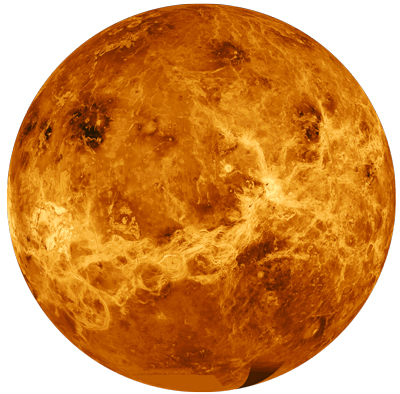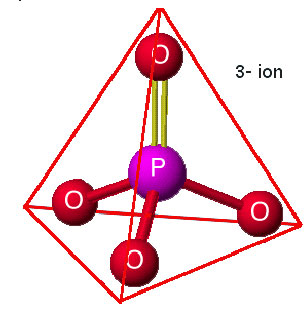Does phosphine prove life on Venus?
Do tiny amounts of phosphine in Venus’s clouds prove that life made it? Why is phosphate vital for life?
First published 20 October 2020; updated 1 July 2021

In mid-September, there were lots of headlines about possible life on Venus. The supposed reason was the discovery of phosphine gas (PH3). Not surprisingly, many of our supporters asked for our comments.
What is phosphine?
Phosphine is an extremely toxic gas that is used to fumigate rats in a building. It is also very important in hi-tech industry, because it is used to add phosphorus atoms to silicon wafers to make n-type semiconductors. These are used in some of the best LEDs, solar panels, and computer chips. But phosphine is supposedly hard to explain unless it was produced by life.
What was found?

As usual, the original paper is not as hyped as many reports on it. The astronomers found microwave absorption at 1.123 mm wavelength at a level consistent with 20 ppb (parts per billion) PH3. Now was this really from phosphine, or from sulfur dioxide (SO2) that has a similar absorption line? Could it have been delivered by meteorites or generated by lightning?
Could phosphine have been made abiotically? There are ways of making phosphine by reacting phosphorus in either strong acid or strong base—Venus’s clouds are mainly sulfuric acid (H2SO4). And if there really is life, could it have come from Earth?
The research team carefully addressed such objections, but were still much more cautious than the reports about it.
Venus: extremely hostile to life
Even after addressing counter-claims, they still agreed, “Even if confirmed, we emphasize that the detection of PH3 is not robust evidence for life, only for anomalous and unexplained chemistry.” They point out that the clouds on Venus are hostile to life, being “extremely dehydrating” and “hyperacidic”.1
Venus’s surface has even more problems. It has the hottest surface of any planet in our solar system. Some people think that our world will end in 12 years because our carbon dioxide (CO2) concentration is 0.04%. But Venus’s atmosphere has 91 times our pressure, and comprises 96.5% CO2. So its surface temperature is 464°C (867°F). Lead melts at only 327.46 °C (621.43 °F).
So far, no one has made any claims that any amino acids or nucleotides have been found, let alone proteins or nucleic acids. The biological molecules needed for any sort of life are unstable even at hydrothermal temperatures, let alone at the surface temperature of Venus. So if there are any such claims, we should be extremely skeptical.
Chemical evolutionists’ inconsistencies
There is a glaring inconsistency in many reports. A simple molecule like phosphine is alleged evidence that it came from life. But the incredibly complex molecules of living organisms are claimed evidence that they came from non-living chemicals via chemical evolution. We should remember this point when similar claims are made about methane or water.
Phosphorus: a missing link in chemical evolution

It makes a change for chemical evolution claims to discuss phosphorus. In the form of phosphate (PO43-), it is an essential element for all life on earth. Phosphate is an important component of ATP, or adenosine triphosphate, the energy currency of life, made by the world’s tiniest motor, ATP synthase.
Phosphate is also an essential part of the backbone of our ‘message molecule’ DNA and the similar RNA. The phosphate makes the DNA an acid, which is why its full name is deoxyribonucleic acid. So why ‘acid’? Because that is what it is under the normal standard chemical definition. The Brønsted–Lowry definition of an acid is a substance which can donate a hydrogen ion (H+) or proton. A base under this criterion is a proton acceptor. Because the DNA backbone contains the phosphate group, its acidity is comparable to that of phosphoric acid (H3PO4). Phosphoric acid is not as strong as sulfuric (H2SO4) or hydrochloric acids (HCl), but stronger than vinegar (acetic acid CH3COOH) or lemon juice (citric acid C6H8O7).
When an acid donates the positively charged proton, the remaining part, called the conjugate base, has one more negative charge. Because DNA is a fairly strong acid, it will have donated all its protons in the cell environment. This means it will be fully negatively ionized. This negative charge provides an electrical force-field that repels a type of negatively charged chemical attacker called a nucleophile. A university Nucleic Acid page explains:
Clearly, a polymer in which monomer units are joined by negatively charged diphosphate ester links should be substantially more stable than one composed of carboxylate ester bonds.2
Without this design feature, DNA would be even more unstable than it already is.
However, a big problem for evolutionists is, where did the phosphate come from? Phosphate is very rare in solution, because it precipitates very easily, e.g. with the abundant calcium, magnesium, iron, or aluminium ions. It is also readily adsorbed by minerals that have lots of aluminium and iron ions, such as clay minerals.
The oceans have only 0.1 ppm phosphate (far less than blood!). So not surprisingly, most phosphate is found in mineral forms, such as apatite (the mineral component of our bones and teeth is hydroxyapatite, Ca10(PO4)6(OH)2. These problems explain why phosphate is a limiting nutrient in many aquatic and terrestrial ecosystems. A limiting nutrient is a rare naturally occurring substance, without which the system can’t grow.

But this is no use to chemical evolution. To make DNA, RNA, and ATP, the phosphate can’t be locked up in a mineral, but must be free in solution, and concentrated. This problem is so acute that many chemical evolutionists are looking for a phosphate-free precursor to life as we know it.3 However, other chemical evolutionists are still trying to search for ways to produce dissolved phosphate, i.e. they realize that life does need phosphate. One proposal is that phosphate accumulated in lakes rich in carbonate (CO32-), which can precipitate the metal ions so they can’t latch on to phosphate. Then evaporation supposedly concentrated phosphate even further.4 Some articles commenting on this have proclaimed the phosphate problem “solved”. But this is a tacit admission that there really was a problem in the first place!5
However, it’s not enough to have phosphate. It won’t combine with the other components of DNA unless it is activated, i.e. combined with a high-energy compound. As usual, purification and activation is merely assumed, not performed. I.e. try to introduce adenosine into any simulated evaporated carbonate lake, at any concentration you like, and see if any adenosine monophosphate is formed. And will this in turn undergo further steps to produce nucleotides, let alone RNA?
Another problem is that the conditions are incompatible with proposed means of producing other important biomolecules. Still another is that life needs calcium and other metal ions for many important processes.
Thus, there are myriad reasons why phosphorus is a stumbling block to any chemical evolutionary scenario.6
Update, 7 Nov 2020: phosphine not found after all
Several groups have questioned the original study. It is more likely that the supposed phosphine signal came from sulfur dioxide after all.7
Update, 1 Jul 2021: Lack of water means Venus can’t support even the most robust life
A new study has shown that the water content of Venus’ atmosphere is so low that “Even the most drought-tolerant of Earth's microbes [extremophiles] wouldn't stand a chance on Venus.”8 John Hallsworth, a microbiologist at Queen's University in Belfast, U.K., and lead author of the paper,9 said:
When we looked at the effective concentration of water molecules in those clouds, we found that it was a hundred times too low for even the most resilient Earth organisms to survive. That’s an unbridgeable distance. … Living systems including microorganisms are composed mainly of water and without being hydrated, they can’t be active and are unable to proliferate.8
The paper has implication for life outside Earth in general, highlighting the fact that water is necessary for life [although it’s not sufficient]. The abstract says:
The recent suggestion of phosphine in Venus’s atmosphere has regenerated interest in the idea of life in clouds. However, such analyses usually neglect the role of water activity, which is a measure of the relative availability of water, in habitability. Here we compute the water activity within the clouds of Venus and other Solar System planets from observations of temperature and water-vapour abundance. We find water-activity values of sulfuric acid droplets, which constitute the bulk of Venus’s clouds, of ≤0.004, two orders of magnitude below the 0.585 limit for known extremophiles. Considering other planets, ice formation on Mars imposes a water activity of ≤0.537, slightly below the habitable range, whereas conditions are biologically permissive (>0.585) at Jupiter’s clouds (although other factors such as their composition may play a role in limiting their habitability). By way of comparison, Earth’s troposphere conditions are, in general, biologically permissive, whereas the atmosphere becomes too dry for active life above the middle stratosphere. The approach used in the current study can also be applied to extrasolar planets.9
References and notes
- Greaves, J.S. and 18 others, Phosphine gas in the cloud decks of Venus, Nature Astronomy, 14 Sep 2020. Return to text.
- Reusch, W., Nucleic Acids, msu.edu, 2013; largely based on Westheimer, F.H., Why nature chose phosphates, Science 235(4793):1173–1178, 6 Mar 1987. Return to text.
- Goldford, J.E. and 3 others, Remnants of an ancient metabolism without phosphate, Cell 168(6):1126–1134.e9, 9 Mar 2017. Return to text.
- Toner, J.D. and Catling, D.C., A carbonate-rich lake solution to the phosphate problem of the origin of life, PNAS 117(2):883–888, 14 Jan 2020. Return to text.
- Schulze-Makuch, D., The phosphate problem for the origin of life may be solved, airspacemag.com, 3 Jan 2020. Return to text.
- Thomas, B., Solving the first-life phosphate problem, icr.org, 21 Jan 2020. Return to text.
- Kaufman, M., Strong doubts arise about the reported phosphine biosignature in the atmosphere of Venus, manyworlds.space, 4 Nov 2020. Return to text.
- Pultarova, T., No hope for life in Venus clouds, livescience.com, 21 Jan 2020. Return to text.
- Hallsworth, J.E. and 9 others, Water activity in Venus’s uninhabitable clouds and other planetary atmospheres, Nature Astronomy, 28 Jun 2020. Return to text.





Readers’ comments
Comments are automatically closed 14 days after publication.